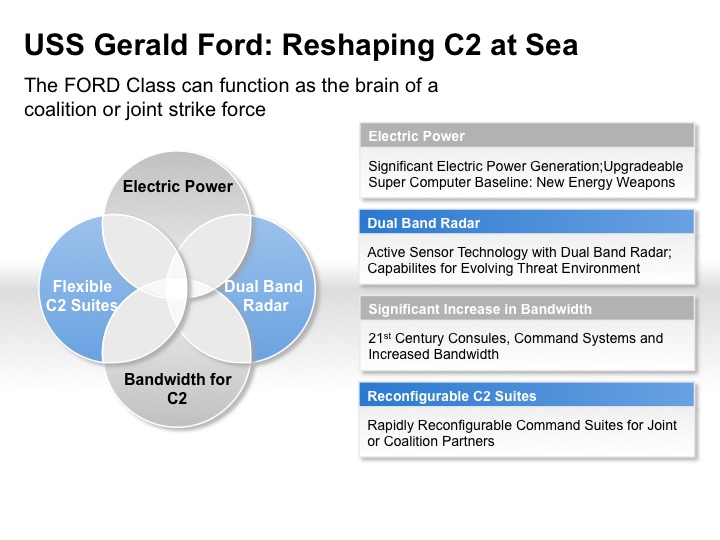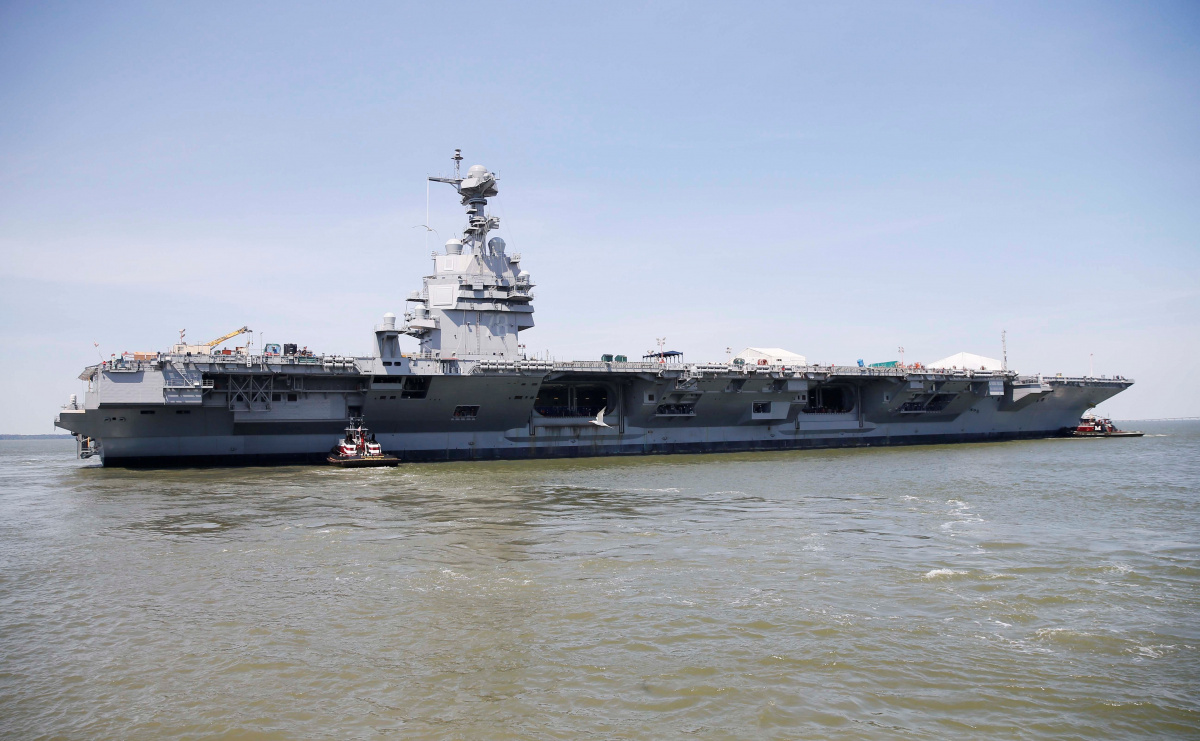The Coming of the USS Gerald Ford
The coming of the USS Gerald R. Ford sets in motion a very different type of large-deck carrier. The hull form of the Ford is a tribute to the very successful Nimitz-class hull design. That is where the comparisons basically end.
As the first CO of CVN 78 put it in an interview with Second Line of Defense at the Newport News shipyard on January 9. 2015:
“We share the same hull design in this class carrier with the Nimitz but everything else is either heavily modified or completely new.”
In effect, the new carrier is built to provide an infrastructure for 21st century warfighting, not just for the U.S. Navy, but for the joint and coalition force as well.
The ship is designed to operate more effectively with an evolving airwing, which will change over the 50+ year life of the carrier.
It has as well significantly greater C2 capabilities so that the carrier can play an expanded role in evolving 21st century U.S. and alliance distributed operations which will be central to U.S. warfighting capabilities going forward.
The significant increase in electric power generation, three times greater than Nimitz, is designed to allow the electronic systems associated with defense, attack and C2 to grow over time as well.
A number of the changes associated with the ship are quite visible: the new launching and recovery systems, the weapons handling system and many other improvements.
For example, an important safety and damage control issue is independently generating steam in a modern galley, which precludes steam lines running through the ship. Another example is the special application of non-skid coatings, which means less upkeep.
All of these changes are significant and important.
But central to rethinking the role of the carrier is the revolution in C2 underway.
In the graphic below, the key elements of the infrastructure enabling the Ford to become a unique C2 asset for the maritime or joint or coalition force.

The super computers onboard the ship, with the power to support them as well as having significant power available for system cooling along with the deployment of future laser weapons is a crucial baseline for building out of C2 capabilities.
The next generation in active sensor technology in the dual band radars provides a solid foundation, not simply for the organic defense and strikes capability of the carrier, but for the battle fleet as a whole.
Significant increase in bandwidth is a fundamental requirement for an expanded C2 capability at sea which can support land, sea and air operations.
And the unique rapidly reconfigurable command suites on board allow for C2 to be provided for joint or coalition partners in a manner appropriate to the mission set.
As Rear Admiral Manazir, Director of Naval Air Warfare, put in the interview we did with him:
Reach not range is a key aspect of looking at the carrier airwing and its ability to work with joint and coalition forces. This is clearly enhanced with the F-35.
What you can do with a Carrier, given joint and coalition perspectives is the Carrier automatically extends your reach because you can put it anywhere you want. The mobility of the carrier is a key point.
You can put it up against the problem set the national command authority or the joint force commander wishes to address; and then you can move it to deal with an evolving target or operational set of challenges, again aligned with the commander’s intent, you can move the reach of the carrier wing as you redeploy it and connect with joint or coalition assets.
The carrier has a core ability to operate organically but its real impact comes from its synergy with the joint and coalition force, which will only go up as the global F-35 fleet emerges.
And this will get better with the coming of the USS Ford. What the Ford does is it optimizes the things that we think are the most important.
Some of those capabilities are clear:
- Enhanced sortie generation capabilities or the number of times you can get airplanes into the mix to keep the reach out there
- The power generation capability, so advanced systems can operate off of the ship.
- The ability to take the information that is brought back through the airborne network into the ship and be able to disseminate it to decision makers is enhanced over the Nimitz class.
- The enhanced reliability of the entire ship that should result in fewer yard visits, thus extending the ability to deploy more often.
The interview with the Captain highlighted a number of the key elements of change associated with the Ford, which will allow it to play a robust 21st century warfighting role.
The Captain’s background suggests a robust capability to think through the kind of innovation the ship will foster.
He comes from the electronic attack community and then went through the demanding nuclear schools of the USN and became the Executive Officer of the USS Harry S. Truman and then the for his “deep draft” tour he was CO of the USS Gunston Hall.
His increasing responsibility at sea from flying off the deck to Command provides a solid foundation for the kind of innovative and creative thinking that is necessary to put together operationally such a complex enterprise as a 21s Century large deck carrier and its air wing.
“Clearly, the ship is designed to enhance the sortie generation rate of the airwing.
But, less noticeable, is that the Ford is a vastly improved command and control platform as well.
The new phased array radars are going to be the most capable ones on the water. They will open up a window on new levels of C2 and new ways of fighting and communicating and controlling communication flows.”
Question: The new launch and recovery systems coupled with the new weapons handling systems will give you significant flexibility as the air wing evolves.
Could you give us your perspective on this?
Captain Meier: The EMALs system we will visit on board the ship and will allow us to provide for an ability to launch aircraft more smoothly and with less wear and tear on the airplanes and the pilots.
Coupled with the new advanced arresting gear, we will be able to launch and recover a variety of types of aircraft, including future designs that haven’t been developed.
What the arresting gear and the catapult do is they give you better energy absorption, meaning you can launch heavier, faster aircraft than are on the drawing boards today.
You can also launch and recover lighter aircraft than currently fielded.. The legacy landing systems are essentially at their limits in terms of weights of aircraft and maintainability.”
Question: What you’re basically saying is the Navy is enhancing its ability to be able to launch different types of aircraft because you’re not constrained by a catapult system that has to be resized for each aircraft coming out of the launch.
So you can mix and match packages appropriate to mission set.
Could you comment on this development?
Captain Meier: Your point is absolutely right on.
That also goes to not just launch and recovery of aircraft, but the types of ordinance that’ll be happening 30, 40, 50 years from now as well will change dramatically.
We anticipate directed energy weapons being onboard the ship, and a significant evolution of the weapons carried by the carrier.
The new weapons handling system is designed to be able to handle the weapons of the future as well.
You have a great capacity for diversity of weapons, and the advanced weapon elevators themselves are located on the ship to facilitate faster movement and loading of the weapons. That’s the underlying principle of the advanced weapon elevators.
The elevators carry more weight and they go faster, twice the speed and twice the weight essentially of the legacy weapons elevators.
They’re located in the flight deck, which puts them positionally where the crew will spend a lot less time from an ergonomics perspective pushing the ordnance around.
The ordnance comes up right near the aircraft and facilitates more efficient weapons loading.
Question: Could you discuss the power generation capability of the ship and its impacts?
Captain Meier: We’ve got three times the electrical power generated onboard Ford compared to Nimitz. Nimitz is pretty much at the edge of her envelope for available electrical energy.
We’ve got tons of room for growth.
We have excess power, the excess electrical capacity for weapons systems that we don’t know about yet like lasers, direct energies, all those sorts of things are in the art of the possible in the period ahead.
Question: The power generation and cooling, and the computer-based capabilities of the ship coupled with the new radars clearly create a foundation for the evolution of C2.
But what is not widely realized, and we certainly did not before coming onboard the ship, is the impact of what you call flexible infrastructure.
Could you explain what this is and what its impact might well be?
Captain Meier: Flexible infrastructure is a part of the ship built with reconfigurable work areas. Imagine this part of the ship as offices with movable walls where you could set up workspaces how you want them to operate for the task. And you have electrical power in this space to use as you wish.
These spaces can be configured appropriate to a particular C2 scenario whether for the USN, the joint or coalition force onboard the ship.
Question: This ship is built with 21st century engineering, design and manufacturing tools.
Obviously, first of class is always more expensive than what later members of the class cost, and with the Ford when the first is built you have the design tools in place as well.
Could you comment on how one should look at the use of the new design and manufacturing tools to create the USS Gerald R. Ford?
Captain Meier: The manufacturing changes are substantial. When we talk about modeling and simulation, we have a simulator, which can model, down to the level of people walking across the flight deck, whether it’s moving ordnance or aircraft.
That’s the level of detail that we have in some of that modeling. One of the other great products of the ship has developed and the Navy’s purchased is the 3D model which is essentially designed in a computer to provide a complete 3D model of the ship and its operations.
So you could in the computer design even with 3D goggles.
You can move assets around to determine where best to place it or better position it.
There are many components or large sized components that may need to be removed so, from a design perspective, a ship has designed removable paths and you can do all of that.
The models will also be used to drive change plans down the road. And they are also important in doing maintenance on the ships.
Question: Clearly, the ship has a lot of up front design and infrastructure built in to make it a more cost effective ship to operate from a maintenance point of view. Could you give us a sense of the importance of this build-into the ship?
Captain Meier: By design there are fewer components and the components that we have are generally designed for the life of the ship.
Many of the components here will last the life of the ship.
The design of having fewer components and more robustly designed components clearly will enhance maintainability.
And with other changes built into the ship, we will reduce the required crew size as well, with 700 fewer Sailors being required to operate an even more complex warship than the Nimitz.
This would not have been possible without 21st century design and manufacturing techniques.
This article was first published on January 24, 2015

